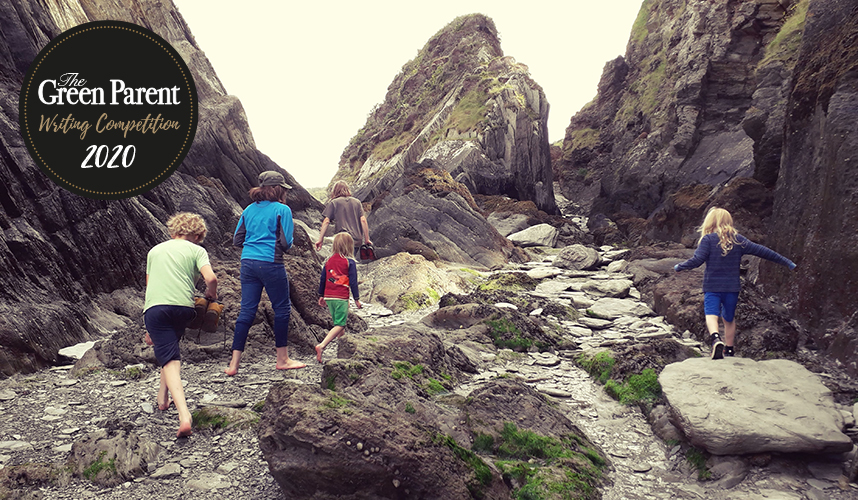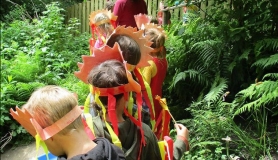We all want the best for our children.
I want my children to grow up to be happy and well adjusted; to be able to make informed choices and be independent; to have a sense of connection with and respect for the world in which they live: with Nature and with people from all walks of life and cultures; to be kind and have empathy for others; to have a strong sense of identity; to be passionate and have a positive attitude; to always try their hardest and be the best that they can be; to make the morally right choice and be true to their beliefs.
I believe these things cannot be taught at school. In fact, I think they cannot be taught full stop. These things can only be developed slowly, over a long period of time. These values and traits are like tiny seeds that grow in your child’s heart. They need to be nourished and nurtured and it is the stuff of childhood and our love as parents or guardians that will water them.
A true childhood, one where children are free to explore, to wonder, to play, to experiment and to imagine is becoming a rarity. All too often technology, the influences of the media and the hustle and bustle of modern life is snatching childhood away, depriving our children of the chance to connect with others and the world in a real and authentic way.
Our children need a childhood where they are free to just be children.
It is our job as parents to help our children have a childhood where they can grow into happy, confident, capable and independent individuals.
ROOTS TO GROW AND WINGS TO FLY
Children need to be loved.
They need time.
They need freedom.
As Maria Montessori states:
“The two (most important) gifts we can give our children are roots to grow and wings to fly.”
So how can we give our children this wonderful childhood where they can thrive and blossom?
By nurturing our children, giving them strong foundations based on love and kindness, we will help to provide the right conditions for them to flourish.
“If a tree has the right conditions to lay down strong roots then it will be able to blossom into a beautiful strong tree. Likewise if a child is nurtured and nourished they too will grow and blossom.” Nettie Gallagher
Just like a gardener tends his plants, we need to tend our children. We need to support and encourage, guide where needed but at the same time allow freedom to explore, experiment, discover, fail and try again. We need to help them make connections: with the world around them and with people.
We need to let children be children: to escape into the worlds of their imagination; to get messy and make messes; to be noisy and to play; to spend lots of time outdoors, to see and experience the truly amazing and awe inspiring world in which we live; to create special memories and build relationships; to have time and space to reflect.
And most importantly we need to let them know they are loved.
We need to slow down and reconnect and give our children what they deserve and need – a true childhood.
To grow a happy childhood we need to scatter a special blend of seeds, not just once a year, but every day, throughout their whole childhood.
This mix of seeds should include:
· An atmosphere of love
· Time to play
· Freedom to choose
· Time outdoors
· Time to read – together and on their own
· Time to reflect
· Special family memories
AN ATMOSPHERE OF LOVE
Weaving an atmosphere of love throughout childhood is the single most important thing we can do for our children. If a child feels loved and valued then they are more likely to have a higher self-esteem and in turn they will grow in confidence and independence.
Children need to be told that they are loved. They need to be told that they are loved even when they mess up and make mistakes. But more than that, they need to be shown that they are loved. Not in big over-the-top gestures like showering them with expensive presents and extravagant holidays, but in the little everyday things: the special good night kisses, the time taken to sit and read a story with them (yes, even if it is the same story you have read to them dozens of times before!), holding hands on a walk, playing games together, cooking together, sharing meals together, chatting together and listening properly to all their questions and ponderings.
You could try: creating a special family ritual that you do each week
· Have a Bake It Sunday – put on some music you both like and bake a cake with your child. Give your undivided attention to your child and make the cake the centrepiece of a special Sunday Supper.
· Have a special Snuggle Up Time at a particular time each week - move all other commitments out of the way to make it happen. Grab a cosy blanket and a handful of their favourite books and read to your child. Just half an hour on a regular basis is enough to start building up a strong relationship with your child.
TIME TO PLAY
“Play is the highest form of research.” Albert Einstein.
Play is an essential part of childhood.
Play is how children learn about the world in which they live. It provides opportunities for them to explore, investigate, experiment, discover, experience and imagine; to make connections, develop communication skills and form relationships. If they are not given opportunities to have plenty of time for free play their personal growth may become stunted, just like a tree in a pot which will never reach its full height.
Contrary to what the media tells us, play does not require expensive plastic toys. Children are born with a wonderful imagination and a toy that can be repurposed into many different things (such as the humble stick, cardboard box, wooden bricks or a blanket) can have far more open-ended play opportunities and be more versatile than a themed toy aimed at following the latest trend (where play may be limited to pressing buttons to make sounds). These latter toys may have their place but to really encourage your child’s imagination and engagement in play, open ended toys can’t be beaten.
You could try: Encouraging free play
· Strew open-ended resources and loose parts around your home and garden as an invitation to play - You could use anything that might trigger imaginative play appropriate to your child’s age or stage (e.g. pebbles, wooden bricks, pipe cleaners, playdough, balls, guttering, play silks, paints, etc.). If your child doesn’t show any interest you could model how to play and see if they join in. If they still don’t choose to play then just try something different the next day.
· Take play outdoors Head out to your local park, beach or woods and just let your children be free to play and explore. Most children will naturally make up games using the natural world. If your children need some ideas you could suggest they make an elf house, a woodland ‘feast’ using fallen leaves, sticks etc. or make a piece of artwork using natural materials.
FREEDOM TO CHOOSE
Yes, children do need guidance and gentle support, but they also need freedom to choose.
It is in the choosing that children develop important decision making and problem solving skills, adapting their choices the next time if earlier choices weren’t successful. Choosing helps children learn about responsibility, provides a step towards becoming independent and encourages creativity.
It is in the choosing that children feel valued.
It is in the choosing that children develop a sense of identity.
You could try: encouraging free choice
· Have a ‘you choose day’ – let your child choose what to wear, what meals to eat, what to do or where to go. They will love having the freedom and hopefully will learn a few things along the way!
· Set your children a challenge- where they have to work out how to solve a problem or challenge (such as how to throw an egg from a height without it breaking or how to plan a holiday to Disney World). Let them choose how they will approach the task.
TIME OUTDOORS
“Nature has been for me, for as long as I remember, a source of solace, inspiration, adventure, and delight; a home, a teacher, a companion.” – Lorraine Anderson
The natural world is a massive part of my children’s childhood. You can find us outdoors every day, come rain or shine. The benefits of spending time outdoors immersed in the natural world can be seen on a physical, mental, spiritual and creative level and I could write a whole book on the subject. A childhood without access to the natural world would be a sad childhood indeed. The natural world allows them the freedom to explore and play in ways which just cannot be replicated through indoor toys and games consoles. It ignites their imagination and provides endless opportunities for adventures. . . . the proper stuff of childhood!
You could try: incorporating time outdoors into your weekly rhythm
· Have a Fun Friday - set aside a dedicated time to get outdoors in nature either each day or each week. It doesn’t need to be elaborate – anything from a picnic in the park, a simple walk in the woods to a play at the beach. Let your children choose where they want to go and what they want to do and they will be more engaged.
· Look for the extraordinary in the ordinary – take time to stop and listen for birds singing, to feel the warm sunshine on your face and the cool wind in your hair, the intricate pattern of veins on the back of a leaf, how moss on a wall looks like a tiny forest. Children love to notice all these small things that we often just walk past every day
TIME TO READ
“Books and doors are the same thing, you open them and you go through into another world.” Jeanette Winterson
I have barely had to teach my children how to spell or how to write using different literary devices as they have learned naturally, picking up these skills through reading. They are all avid bookworms and my eldest write eloquently. This didn’t happen overnight. It was borne through the many, many hours we have spent snuggled up sharing a book together, through the too-many-to-count trips to the library and the bulging bookshelves. It is through the free time I have given them to snuggle up on their own and just read.
A love of books and reading is such a valuable gift to pass onto your children. It gives them time and space to de-stress if needed and, of course, the chance to escape into all the wonderful worlds and adventures contained within the books, sparking their imaginations. A love of reading, and all its associated benefits, is something that they will carry with them for the rest of their lives.
You could try: fostering a love of reading
· Set up a special cosy reading nook - with fairy lights, blankets and cushions. Make it somewhere special that your children will love to retreat to. You could also add some calm music to play in the background.
· Create a special book basket – Find a special wicker basket, or if you don’t have one you could decorate a cardboard box, and fill it with a feast of wonderful books – ones that will capture their imagination or that have beautiful illustrations. Fill with new books every couple of weeks to sustain interest.
A QUIET SPACE
Children need time to run around and be noisy, but they do also need to have some quiet time. To be still. To unwind. To reflect and make sense of things if need be. Many children do not get this as they are rushed from one activity to another which can lead to feeling overwhelmed. We need to actively build this into our children’s days for their mental and spiritual health.
Things to try: creating opportunities to be calm
· Find a Special Sit Spot – in your local park, woods, beach, garden or even in your home. Get your children to find somewhere that they can feel safe and happy and regularly visit it. Allow your child to just quietly sit there – to observe what is going on around them (e.g. birds singing, cloud formations changing, ants scuttling around, etc.) or to just sit and do a quiet activity like reading or drawing.
· Give time and space – when tempers are becoming frayed, stand back and allow your child (and especially your teen) time to themselves. For teens allow them to go out for a walk to calm down; for younger children try to make sure there is a quiet space somewhere in your home that they can retreat to for a few minutes.
SPECIAL MEMORIES
And lastly, but by no means least, add some magic!
Childhood should be wonder-filled and full of happy memories.
Memories are part of our history. Our story. They help define who we are and influence the way we view the world. As parents and carers we are in the unique and privileged position to be able to influence the memories our children will take with them from childhood.
We need to craft a childhood full of positive and happy memories to give to our children by sprinkling lots of magical moments around that they can tuck away in their hearts as special memories to treasure forever.
You could try: building some special memories together
· Serve up a surprise or do something unusual – why not try having a picnic under the kitchen table, a campfire on the beach on a full moon, a wild walk in the pouring rain, a topsy turvy day (tea for breakfast and breakfast for tea and clothes on back to front or inside out) or staying outside all day long from sunrise to sunset.
· Cultivate family rituals – place some candles on the table at meal times, bake bread together on the Equinoxes, make a solstice spiral to celebrate the Mid-Winter Solstice, have a Poetry Teatime on a Friday afternoon, a weekly walk together or a board games afternoon every Sunday.
BLOSSOM
If we are to fulfil our role as parents then we must strive to gift our children a childhood where they can grow into happy, confident, capable and independent individuals.
Let’s give our children a childhood where they are allowed to be children and one where they can truly blossom.
“(Cherish) the small things
for one day you may look back
and realise they were the big things.”
Robert Brault
Nettie lives close to beautiful beaches, wild moorland and magical woodlands. She is married and eclectically home-educates her 5 children aged 6-16. She loves celebrating the seasons, the smell of the rain on dry earth, reading books and creating a cosy home for her family.
She writes about home-education on her blog at http://www.theblossomtreehomeschool.com and can be found on instagram: @ontheblossomtrail







